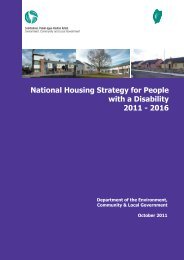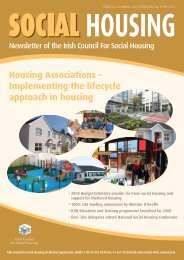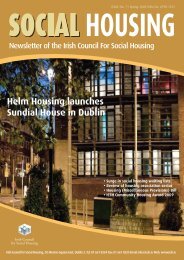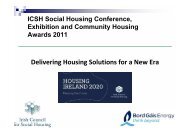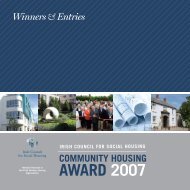Promoting the Benefits of social Housing - The Irish Council for ...
Promoting the Benefits of social Housing - The Irish Council for ...
Promoting the Benefits of social Housing - The Irish Council for ...
You also want an ePaper? Increase the reach of your titles
YUMPU automatically turns print PDFs into web optimized ePapers that Google loves.
Editorial:Could private sector slowdown provide an opportunity <strong>for</strong> <strong>social</strong> housing?Indications are that private residential construction is slowing down based on <strong>the</strong> number <strong>of</strong> starts and planning permissionsgranted. <strong>The</strong>re<strong>for</strong>e, this surplus capacity should now be transferred to boost <strong>the</strong> delivery <strong>of</strong> <strong>social</strong> housing in <strong>the</strong> new NationalDevelopment Plan (NDP) and in turn meet <strong>the</strong> targets agreed by <strong>the</strong> Social Partners in <strong>the</strong> national agreement Towards 2016.In addition to delivering new <strong>social</strong> rented homes, transferring surplus capacity will ensure better value <strong>for</strong> money in <strong>the</strong> statefunding <strong>of</strong> <strong>social</strong> housing as well as providing a ‘s<strong>of</strong>ter’ landing in <strong>the</strong> residential construction sector. While private housingoutput hit record levels in <strong>the</strong> last NDP, <strong>social</strong> housing output always struggled to creep above 10%. Providing <strong>social</strong> housingthrough housing associations and local authorities has both <strong>the</strong> obvious <strong>social</strong> benefits in addressing housing need but also asignificant economic benefit <strong>for</strong> <strong>the</strong> <strong>Irish</strong> economy.Service Indicators in Local Authorities 2006In January 2004, a system <strong>of</strong> <strong>for</strong>mal per<strong>for</strong>mancemeasurement across 42 indicators was implementedthroughout <strong>the</strong> local authority system. This meant thatper<strong>for</strong>mance results <strong>for</strong> each local authority could becompiled and published in a report to <strong>the</strong> Minister <strong>for</strong> <strong>the</strong>Environment, Heritage and Local Government in 2005. <strong>The</strong>results were verified by an independent assessment panel.This is a first in <strong>Irish</strong> public service.<strong>The</strong> third report was published in July 2007 by <strong>the</strong> LocalGovernment Management Services Board (LGMSB) andcontains <strong>the</strong> results <strong>for</strong> each indicator <strong>for</strong> 2006, <strong>the</strong> reportalso compares results at a national level <strong>for</strong> 2004 to 2006. Asummary <strong>of</strong> <strong>the</strong> main findings is presented below.Total number <strong>of</strong> dwellings <strong>of</strong> local authority stock in managementYearNo <strong>of</strong> Dwellings2004 111,4572005 113,6882006 115,386Current Status <strong>of</strong> Local Authority Social <strong>Housing</strong> Stock<strong>The</strong> national total <strong>of</strong> all local authorities has increased by3.5% in two years. Across all local authorities 5,265 (4.6%)<strong>of</strong> dwellings are empty compared with 3.9% <strong>of</strong> all dwellingsin 2004. Some <strong>of</strong> <strong>the</strong>se empty dwellings are those subjectto major refurbishment schemes which will increase <strong>the</strong>quality <strong>of</strong> <strong>the</strong> housing stock. <strong>The</strong> figures also show a smallimprovement in <strong>the</strong> average time taken to re-let dwellingsfrom 4 weeks in 2004 to 3.8 weeks in 2006. <strong>The</strong>re is also anincrease <strong>of</strong> 3% in <strong>the</strong> average number <strong>of</strong> repairs completedin 2006 relative to 2004. In 2006 <strong>the</strong> average percentage <strong>of</strong>repairs completed was 87.8% <strong>of</strong> <strong>the</strong> number <strong>of</strong> valid repairrequests received.Average time (days) to in<strong>for</strong>mapplicants <strong>of</strong>: 2004 2006Shared Ownership 14 8.7<strong>Housing</strong> Loan 15 8Local Authority <strong>Housing</strong> 28 29.5Dealing with Applications <strong>for</strong> Social <strong>Housing</strong><strong>The</strong> average times taken to in<strong>for</strong>m applicants has marginallyimproved since 2004, with <strong>the</strong> exception <strong>of</strong> <strong>the</strong> time takento in<strong>for</strong>m applicants <strong>of</strong> local authority housing, as can beseen from <strong>the</strong> table below.It is clear from <strong>the</strong>se results that <strong>the</strong> assessment andverification processes vary greatly, moreso in <strong>the</strong> averagetime to in<strong>for</strong>m applicants <strong>of</strong> local authority housing. InFingal County <strong>Council</strong>, <strong>the</strong> average is reported as 270 dayswith <strong>the</strong> explanation that <strong>the</strong>re was a significant increasein <strong>the</strong> housing list in 2006. <strong>The</strong> average time is nowreported as down now to 28 days. Galway County <strong>Council</strong>and Kerry County <strong>Council</strong> reported on average 104.9 and121.3 days respectively.Per<strong>for</strong>mance Management <strong>for</strong> <strong>Housing</strong> AssociationsEnsuring that proper standards continue to be achievedis also a key objective <strong>for</strong> voluntary housing associations.<strong>The</strong> ICSH undertook a two phased pilot project known asHAPM – <strong>Housing</strong> Association Per<strong>for</strong>mance Managementto assist in developing a framework <strong>for</strong> measuringper<strong>for</strong>mance in housing management <strong>for</strong> <strong>the</strong> sector.<strong>The</strong> main areas <strong>of</strong> <strong>the</strong> framework that member housingassociations agreed to measure included <strong>the</strong> followinghousing management functions:• Rent Control• Allocations / Lettings• Vacancies / Voids• Repairs & Maintenance• Landlord / Tenant Relations• Customer Service<strong>The</strong> ICSH are currently examining <strong>the</strong> roll out <strong>of</strong> a refinedHAPM framework comprising <strong>of</strong> 10 Key Per<strong>for</strong>manceIndicators <strong>for</strong> <strong>the</strong> sector. <strong>The</strong>se KPIs are based on thoseelements <strong>of</strong> housing management that are <strong>of</strong> interestto both tenants and o<strong>the</strong>r stakeholders and that provide<strong>the</strong> most appropriate in<strong>for</strong>mation on how well <strong>the</strong>housing service is managed. It is anticipated that, in time,per<strong>for</strong>mance results <strong>for</strong> <strong>the</strong> voluntary sector can alsobe reported on an ongoing basis. <strong>The</strong> objective at somestage would be to gain some comparison on housingmanagement outcomes between local authorities andhousing associations.ICSH Social <strong>Housing</strong>



